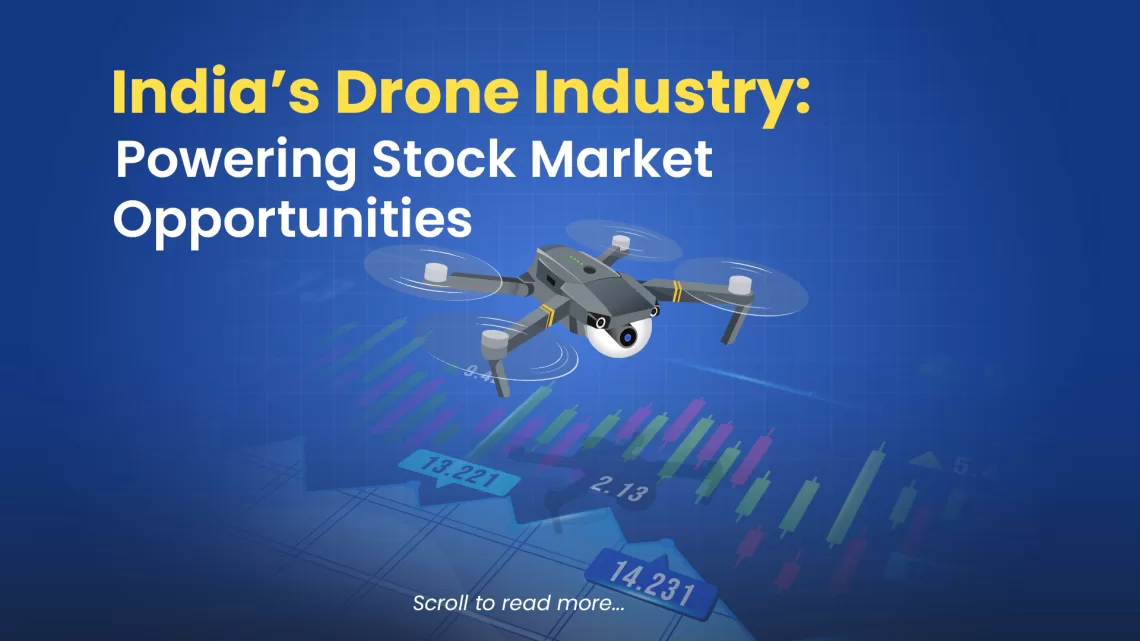Key Takeaways
- Growing Ecosystem: India’s drone industry is expanding fast with over 600 companies, strong government support, and a vision to become a global drone hub by 2030.
- Government Push: Initiatives like the PLI scheme, Drone Rules 2021, import bans, and programs like Drone Shakti and Drone Didi are driving domestic manufacturing.
- Sector-wise Demand: Drones are being widely used in defence, agriculture, logistics, mapping, and infrastructure, creating opportunities across multiple industries.
- State-Level Growth: States like Tamil Nadu are becoming drone manufacturing hubs, with startups like Garuda Aerospace gaining attention and building war-ready drone systems.
- Opportunities & Challenges: While the sector promises massive growth, it still faces hurdles like lack of skilled manpower, tech dependencies, and weak component supply chains.
Table of Contents
“India is aiming to become a drone hub of the world,” said Rajnath Singh at the Delhi Defence Dialogue.
I still remember the first time I watched a drone hover silently above me in a marriage function, its rotors whispering something I did not understand back then.
But now, I do ”Opportunity of Investment”!
These tech marvels have gone far beyond YouTube vlogs and marriage shoots: they’re reshaping warfare, farming, construction, and even the way money flows on Dalal Street.
The drone industry was about USD 73 billion in 2024 and is racing towards USD 84 billion by end‑2025, with a healthy 14 percent annual growth forecast through 2030.
Roughly 40 percent of that pie comes from defence think surveillance, loitering munitions, counter‑drone tech, while the rest covers everything from crop spraying, package delivery, and video shoots. And in this, North America still leads, but Asia-Pacific (led by China and India) is the fastest‑growing region.
Civil Aviation Ministry projections (cited by KPMG) put the entire industry at ₹120-150 billion (~USD 1.5-1.9 billion) by 2026.
MoCA officials expect a growth from ₹60 crore to ₹900 crore: Domestic drone manufacturing annual sales turnover has exploded and is expected to hit ₹900 crore by 2025 from the 60cr mark in 2021.
The first Production-Linked Incentive (PLI) injected ₹120 crore in 2021; rumours of a ₹1,000 crore PLI 2.0 are already there to boost local parts from 50 percent to 30 percent of the value chain.
What is PLI? Production Linked Incentive (PLI) scheme is a scheme that provides incentives to companies for enhancing their domestic manufacturing. Drone Rules 2021 ditched most individual licenses, shifted to a one-stop UDAN‑drone portal, and carved out five UAV corridors, sending registered drones from 346 in July 2022 to over 5,000 by July 2023.
How the Drone Industry Affecting the Indian Stock Market?
As defense contracts and commercial deployments accelerate, publicly listed companies tied to drone manufacturing and services are drawing investor attention.
The interplay of government backing, huge order books, and technological innovation has spurred share‑price rallies, with analysts betting that early movers could become market leaders in this burgeoning sector.
- Fast‑track buys: In May 2025, India ordered 450 of the indigenous Nagastra-1R “suicide drones” (after 480 in 2024), underlining a real push for self‑reliance.
- Startups: Raphe mPhibr just bagged a US $100 million Series B, India’s biggest drone raise ever, bringing its total funding to $145 million and flying mission‑critical UAVs to our forces.
- Industrial Clusters: Tamil Nadu is emerging as a drone hub, home to innovators like Dhaksha, Garuda Aerospace, Zuppa Geo Navigation, and Big Bang Boom, backed by a state defence corridor and four UAV test centres.
Government Initiatives to Enhance India’s Drone Ecosystem
India’s policymakers have pulled out every lever to accelerate local growth:
- Production-Linked Incentives (PLI): The inaugural PLI scheme for drones injected ₹120 crore in 2021 to kickstart domestic manufacturing. Now, in the wake of heightened tensions with Pakistan, the government is rolling out an even larger ₹2,000 crore (USD 234 million) incentive program over three years, nearly double the original, aimed at boosting local component content to at least 40 percent by FY 2028 Reuters.
- Drone Rules 2021 & UDAN‑Drone Portal: Simplified regulations have eliminated most individual permits, routing approvals through a single “UDAN‑Drone” online portal. Dedicated UAV corridors and test zones have multiplied registered drones from 346 (July 2022) to over 5,000 by July 2023.
- Agritech Subsidies: Under various agricultural missions, farmers and custom‑service operators can receive grants of up to ₹10 lakhs for drone purchases, driving usage in crop monitoring, spraying, and precision farming.
- Defence Fast‑Track Procurements: May 2025 saw a fresh order of 450 indigenous Nagastra‑1R “suicide drones” (on top of 480 units ordered in 2024), underscoring a laser focus on self‑reliance.
Collectively, these measures underpin a projected industry turnover leap from roughly ₹60 crore in 2021 to ₹900 crore by 2025 and a nationwide market worth ₹120-150 billion (USD 1.5–1.9 billion) by 2026
Key Drone Stocks Riding the Momentum
- IdeaForge: The pure-play drone stock, think police, para‑military orders. P/E’s rich at ~45x FY 26E, but export wins could send it sky‑high.
- Zen Technologies: A pure defence‑tech, recently bagged its 54th patent and took a 55% stake in loitering‑munitions maker TISA Aerospace. Strong R&D and fresh orders could re‑rate Zen Technologies‘ valuation.
- RattanIndia/NeoSky: Building a drone ecosystem (hardware, services, software) via ties with Matternet and a 60% stake in TAS. Backed by a ₹100 crore rollout fund, but still scaling up.
- DTT: An engineering genius who makes drone parts and assemblies. Steady and a bit cyclical when defence budgets wobble.
Risks and Challenges for Investors
Supply‑Chain Vulnerabilities: Crucial sensors, motors, and imaging modules remain largely imported. While PLI schemes aim to localize production, upfront capital expenditures are significant.
Regulatory Hurdles: Beyond basic licensing, beyond‑visual‑line‑of‑sight (BVLOS) operations, air‑traffic integration, and data‑privacy frameworks still need clarity, missteps could ground entire programs.
Global Competition: China’s DJI commands roughly 70 percent of the civilian market. Indian firms must carve deep niches or secure substantial capital to challenge entrenched players.
The Burgeoning Drone Industry
The Russia-Ukraine war was the wake-up call. Over 10,000 commercial drones (mostly DJI) were deployed by Ukrainian forces in 2022–2023 alone for surveillance, targeting, and even kamikaze-style attacks.
Russia responded by deploying Iranian-made Shahed-136 drones, striking Ukrainian infrastructure hundreds of kilometers away, cheap, effective, and hard to intercept. India, observing this tectonic shift, isn’t sitting idle.
With fast-tracked orders of 930 Nagastra-1R kamikaze drones in just two years, and the Defence Minister publicly vowing to make India a global drone hub, this isn’t a tech trend, it’s a national strategy.
So, for stock market investors, the message is clear: Drones are no longer optional, they’re inevitable. And those who spot the lift-off, early be it IdeaForge, Zen Tech, or NeoSky, may just find themselves holding tomorrow’s most strategic multi-baggers.
*These stocks are only recommended for explanation purposes.
Frequently Asked Questions (FAQs)
What is driving the growth of the drone industry in India?
A combination of simplified regulations (Drone Rules 2021), generous PLI incentives, defence procurement push, and agritech subsidies has unleashed pent‑up demand across commercial and military segments.
Which sectors in India are actively using drones?
Key adopters include defence (surveillance, loitering munitions), agriculture (crop monitoring and spraying), construction and infrastructure (site surveys), logistics (last‑mile delivery pilots), and media (aerial filming).
What is the PLI Scheme?
The PLI (Production Linked Incentive) Scheme is a government program that gives financial rewards to companies for making products in India. It aims to boost local manufacturing, reduce imports, and increase exports. The scheme covers sectors like electronics, pharma, drones, and more to grow jobs and investment in India.
How does the PLI Scheme support drone manufacturing?
India’s drone‑focused PLI initially allocated ₹120 crore over three years for OEMs and component makers. The new ₹2,000 crore program (FY 2025-28) further boosts incentives for localizing at least 40 percent of key parts, along with low‑interest R&D loans via SIDBI.











